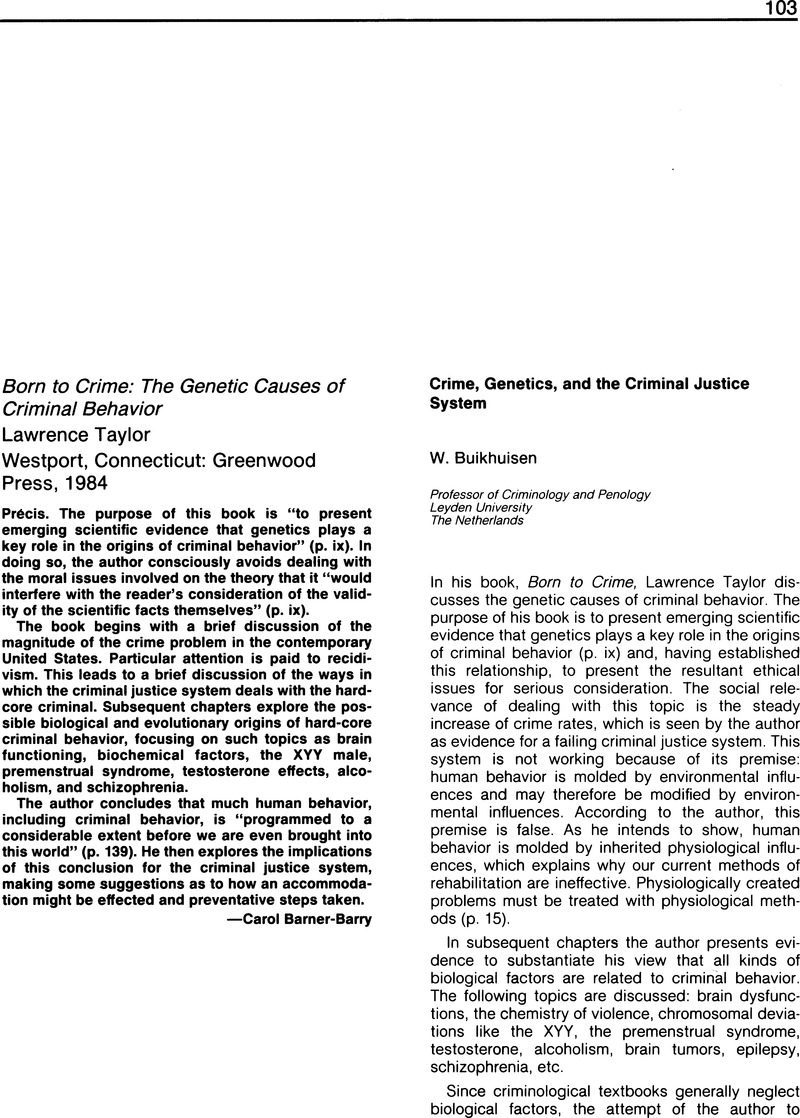No CrossRef data available.
Article contents
Crime, Genetics, and the Criminal Justice System
Published online by Cambridge University Press: 17 May 2016
Abstract
An abstract is not available for this content so a preview has been provided. Please use the Get access link above for information on how to access this content.

- Type
- Book Reviews
- Information
- Copyright
- Copyright © Association for Politics and the Life Sciences
References
Borgström, C. A. (1939). Eine Serie von Kriminellen Zwillingen. Archiv für Rassenbiologie.Google Scholar
Buss, A. H., and Plomin, R. (1975). A Temperament Theory of Personality Development. New York: John Wiley & Sons.Google Scholar
Cadoret, R. J. (1978). “Psychopathology in Adopted-Away Offspring of Biologic Parents with Antisocial Behavior.” Archives of General Psychiatry. 35: 176–84.CrossRefGoogle ScholarPubMed
Christiansen, K. O. (1977). “A Preliminary Study of Criminality among Twins.” In Mednick, S. A. and Christiansen, K. O. (eds.), Biosocial Bases of Criminal Behavior. New York: Gardner Press.Google Scholar
Crowe, R. (1975). “An Adoptive Study of Psychopathy: Preliminary Results from Arrest Records and Psychiatric Hospital Records.” In Fieve, R., Rosenthal, D., and Brill, H. (eds.), Genetic Research in Psychiatry. Baltimore, Md.: Johns Hopkins University Press.Google Scholar
Dalgaard, O. S., and Kringlen, E. (1976). “A Norwegian Twin Study of Criminality.” British Journal of Criminology 16: 213–232.Google Scholar
Dugdale, R. (1884). The Jukes, A Study in Crime Pauperism, Disease and Heredity. New York.Google Scholar
Hutchings, B., and Mednick, S. A. (1974). “Registered Criminality in Adoptive and Biological Parents of Registered Male Criminal Adoptees.” In Mednick, S. A., et al. (eds.), Genetics, Environment and Psychopathology. Amsterdam: North Holland (American Elsevier).Google Scholar
Legras, A. M. (1932). Psychose en Criminaliteit bij Tweelingen. Utrecht: Kemink en Zoon N. V.Google Scholar
Mednick, S. A., Gabrielle, W. F. Jr., and Hutchings, B. (1983). “Genetic Influences in Criminal Behavior: Evidence from an Adoption Cohort.” In Teilmann Van Dusen, K. and Mednick, S. A. (eds.), Prospective Studies of Crime and Delinquency. Boston: Kluwer Nijhoff Publishing.Google Scholar
Rosanoff, A. J., Handy, L. M., and Rosanoff, F. A. (1934). “Criminality and Delinquency in Twins.” Journal of Criminal Law and Criminology 24: 923–924.Google Scholar
Stumpfl, F. (1936). Die Ursprunge des Verbrechens. Dargestellt am Lebenslauf von Zwillingen. Leipzig: Georg Thieme.Google Scholar
Yoshimasu, S. (1965). “Criminal Life Curves of Monozygotic Twin-pairs.” Acta Criminologiae et Medicinae Legalis Japanica.Google Scholar


